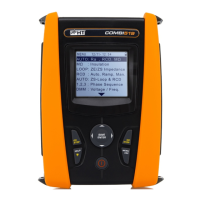
Do you have a question about the HT EASYTEST COMBI519 and is the answer not in the manual?
| Brand | HT |
|---|---|
| Model | EASYTEST COMBI519 |
| Category | Measuring Instruments |
| Language | English |
Instructions for safe and proper use of the instrument, including environmental conditions and accessories.
Recommendations for safe operation during measurements, including disconnecting test leads and avoiding touching terminals.
Instructions for turning off the instrument and battery removal for long-term storage.
Explains measurement categories (IV, III, II, I) as defined by IEC/EN61010-1.
Introduces the manual and lists instrument models and their functions.
Lists the various tests the instrument can perform, such as RPE, MΩ, LOOP, LoZ, ΔV%, RCD, AUTO, 1,2,3, DMM.
Recommends checking the instrument for any damage suffered during transport and verifying package contents.
Details the battery type used and mentions the AutoPower OFF function.
Identifies the front and upper parts of the instrument, including inputs and controls.
Illustrates and labels the components of the measuring leads.
Explains the function of each key on the instrument's keyboard.
Describes the instrument's LCD display module and its capabilities.
Explains how to access and modify instrument settings.
Describes how to select the instrument's language from a list of options.
Explains how to select the country, which affects LOOP and Ra measurements.
Details setting parameters like nominal voltage, frequency, system type, contact voltage, RCD/RCCB, and Isc Factor.
Describes enabling/disabling auto power off, key beeps, and auto start functions.
Explains the AutoStart feature for RCD and LOOP measurements.
Guides on setting the system date and time, including format selection.
Details the automatic sequence of measurements for Ra, RCD, and MΩ.
Describes how the instrument handles anomalous situations during the AUTO test, like voltage errors or lead inversions.
Explains the DMM function for reading TRMS voltage and frequency.
Explains the RPE function for measuring protective conductor resistance.
Explains the TMR mode for continuity testing, including setting duration and results interpretation.
Describes the > < mode for compensating cable resistance in continuity tests.
Details anomalous situations encountered during RPE continuity testing.
Explains the LoΩ function for continuity testing with 10A.
Lists anomalous situations for the LoΩ 10A continuity test.
Introduces the MΩ function for insulation resistance measurement.
Explains the TMR mode for insulation resistance, including DAR and PI calculations.
Details the AUTO mode for sequential insulation resistance measurements.
Lists anomalous situations for insulation resistance measurement.
Introduces the RCD test function for differential switches.
Details parameter settings for RCD tests (MODE, IΔn, Type, Ut).
Explains the AUTO mode for RCD testing, including the sequence of tests.
Describes another AUTO mode for RCD testing with a different sequence.
Explains the x½, x1, x5 modes for RCD testing.
Describes the Mode for RCD tripping time detection.
Lists anomalous situations for RCD testing, including frequency and voltage errors.
Introduces the LOOP function for impedance and earth resistance measurement.
Explains different test types within LOOP function: Ra, Br.Cap, TripT, STD.
Details the ZEROLOOP procedure for calibrating test cables.
Describes the STD mode for generic impedance and short-circuit current measurement.
Explains the Br.Cap mode for verifying protection device breaking capacity.
Describes the TripT mode for verifying protection coordination.
Explains the Ra 2-wire test for indirect contact protection verification.
Explains the Ra 3-wire test for indirect contact protection verification.
Explains verification of protection against indirect contacts in IT systems.
Explains verification of protection against indirect contacts in TT systems.
Explains verification of protection against indirect contacts in TN systems.
Lists anomalous situations for LOOP testing, including frequency and voltage errors.
Introduces the LoZ function for high-resolution line/loop impedance.
Explains the 1,2,3 function for phase sequence and concordance testing.
Lists anomalous situations for phase sequence testing, like frequency or voltage errors.
Introduces the ΔV% function for evaluating voltage drop.
Details how to set parameters for voltage drop measurement (MODE, Inom, Lim, Z><).
Describes performing Z1/Z2 impedance measurements and interpreting voltage drop results.
Lists anomalous situations for voltage drop measurement, including frequency, voltage, and lead errors.
Details the process of saving measurements, including markers and comments.
Explains how to recall saved data and delete memory contents.
General precautions for using and storing the instrument.
Step-by-step guide for replacing the instrument's batteries.
Instructions for cleaning the instrument.
Details specific technical characteristics like voltage, frequency, continuity, insulation, and impedance ranges.
Lists reference standards and guidelines relevant to the instrument's design and function.
Provides general mechanical, power supply, and display characteristics.
Details environmental conditions for instrument use and storage.
Outlines the terms and conditions of the instrument's warranty.
Provides guidance on troubleshooting and contacting after-sales service.
Explains the theory behind checking continuity of protective conductors.
Explains the purpose and allowable values for insulation resistance tests.
Details the measurement of Polarization Index (PI) and its interpretation.
Details the measurement of Dielectric Absorption Ratio (DAR) and its interpretation.
Explains the test for checking circuit separation in SELV, PELV, and isolated systems.
Explains the purpose and allowable values for testing differential switches (RCDs).
Explains how to verify the breaking capacity of protection devices.
Explains how to verify protection against indirect contacts in TN systems.
Explains the Ra test in TN systems for indirect contact protection.
Explains how to verify protection against indirect contacts in TT systems.
Explains how to verify protection against indirect contacts in IT systems.
Explains how to verify protection coordination for different phase configurations.
Explains how to verify voltage drop on mains.